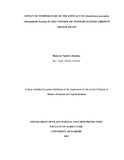| dc.description.abstract | Metarhizium anisopliae isolate ICIPE69 is a highly virulent fungal pathogen against several thrips species such as western flower thrips (Frankliniella occidentalis), bean flower thrips (Megalurothrips sjostedti), onion thrips (Thrips tabaci) and others infesting key vegetable crops in Africa. Recently the isolate has been commercialized for pest control under the trade name, Campaign ®. The efficacy of the entomopathogenic fungi is known to be influenced by the prevailing climatic conditions with temperature being a key climate driver. This study aimed to predict the efficacy of Campaign® for thrips control in different Agro ecological zones (AEZ) in Kenya. To achieve this, effects of different temperatures on spore germination, radial growth, sporulation and virulence of the test fungus against F. occidentalis on French beans were evaluated and a cubic model was used to establish the efficacy of entomopathogenic fungus in relation to temperature. Further this model was run on a temperature geographic information system and a map was developed to predict the efficacy of entomopathogenic fungus at geospatial scale.
The test fungus was exposed to different temperatures; 10, 15, 20, 25, 30, 35 and 40ºC in the laboratory to assess impacts on spore germination, radial growth and sporulation. French beans pods were sprayed with incremental concentrations of the test fungus at; 106, 107 and 108 conidia ml-1 to check the mortality of the adult and second instars of F. occidentalis and were incubated at above temperatures. A field experiment was also conducted at different AEZs (low, mid and high); where the fungus was tested at higher concentrations of 1012 and
xiii
1013 in comparison with an insecticide (Imidacloprid 0.125 g/L a.i) on two French bean varieties.
Temperatures ranging from 20 to 35ºC were found to be suitable for spore germination, radial growth and sporulation of the fungus. At 25 and 30ºC, the isolate induced 100% mortality to adult F. occidentalis in six days. The adult thrips were more susceptible to the test fungus than the second instars. Field application of M. anisopliae at 1013 conidia/ha on French beans at weekly intervals was equally effective as the application of Imidacloprid. There was a significant difference (p < 0.001) in the yield of French beans between fungus treated and untreated plots.
The findings of this study highlight the importance of temperature influences on the activity of M. anisopliae ICIPE69. The optimum temperature for the fungal activity both in the field and laboratory was 25 and 30ºC. Metarhizium anisopliae has a broad temperature range, thus increasing the potential for its usage in various regions. The test fungus was not affected by the AEZs since most the temperatures at the three locations were favourable for the activity of the fungus. The cubic model could be used as a support tool to predict the efficacy of ICIPE69 in relation to temperature. | en |

